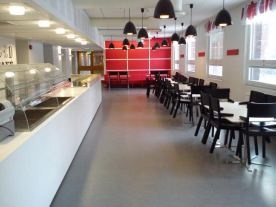March 20, 2013 - Gamla Biskopshuset, Biskopsgatan 1, Lund, Sweden
IEA SHC Task 50
 Lighting accounts for approximately 19 %, i.e. 2900 TWh, of the global electric energy consumption. Research and developments in the field of energy efficient lighting techniques encompassing daylighting, artificial lighting and lighting controls combined with activities employing and bringing these techniques to the market can contribute significantly to reduce worldwide electricity consumptions and C02 emissions. With a small volume of new buildings in the developed countries, major lighting energy savings can only be realized by retrofitting the building stock. However, lighting retrofits are still lagging behind in relation to what is economically and technically feasible. Reasons for this shortfall include: lack of awareness, confusing variety of retrofit solutions, missing evidence of the saving potential taking into consideration emerging technologies, insufficient technical and constructive solutions, missing integrated rating methods regarding energy and operational costs, and a lack of incentives.
Lighting accounts for approximately 19 %, i.e. 2900 TWh, of the global electric energy consumption. Research and developments in the field of energy efficient lighting techniques encompassing daylighting, artificial lighting and lighting controls combined with activities employing and bringing these techniques to the market can contribute significantly to reduce worldwide electricity consumptions and C02 emissions. With a small volume of new buildings in the developed countries, major lighting energy savings can only be realized by retrofitting the building stock. However, lighting retrofits are still lagging behind in relation to what is economically and technically feasible. Reasons for this shortfall include: lack of awareness, confusing variety of retrofit solutions, missing evidence of the saving potential taking into consideration emerging technologies, insufficient technical and constructive solutions, missing integrated rating methods regarding energy and operational costs, and a lack of incentives.
Task 50 targets building owners (investors), authorities, industry and consultants by providing strategic, technical and economic information and by supporting stakeholders to overcome barriers in retrofitting lighting installations. The overall objective of Task 50 is thus to provide information and tools to governments in order to accelerate the development of efficient solutions for retrofitting lighting in the non-domestic sector using cost-effective, best practice approaches, which can be used on a wide range of typical existing buildings. The role of Task 50 participants is to identify and document the best (proven) solutions and strategies, taking into account opportunities and barriers.
The scope of Task 50 is on general lighting systems for indoor environments. The focus is on lighting appliances in non-domestic buildings. Technically, Task 50 addresses daylight utilization through better façade/roof technologies and architectural solutions, electric lighting schemes as well as lighting control systems and strategies.
Objective of the Workshop
- Task experts will inform about general lighting retrofit issues and possible solutions
- General experience exchange between industry and research
- Obtain feedback of industry and practitioner needs to initiate development of IEA Task 50
Agenda (Presentations available when underlined)
9:00–9:15
Welcome and coffee
9:15-10:50
Advanced Lighting Solutions for Retrofitting Buildings: Objectives of IEA Task 50,
Jan de Boer, FhG-IBP, Germany
New daylighting solutions for old buildings: Renovation of the Friedrich-Fröbel-School in Olbersdorf
Roman A. Jakobiak, Architect, dayligthing.de, Berlin
A baseline LED lighting retrofit: measurements and user experiences from Horsens Town Hall, Denmark
Werner Osterhaus, Aarhus University, Denmark
Dynamic solar shading for better visual comfort and daylight utilization
Anders Hall, ES-SO + Somfy Sweden
10:50-11:00
Coffee break
11:00-12:20
Possible financial models to justify lighting retrofits: where are the benefits? Possible opportunities with SSL technology
Marc Fontoynont, Danish Build. Research Inst. (SBI), Denmark
EnPROVE – Workflow and Tooling for Professional Lighting Retrofits
Peter Fuhrmann, Lighting Control Systems Group, Philips Research
From research tools and instruments to lighting retrofit practice
Jérôme Kämpf, EPFL, Switzerland
Lighting retrofits: yes! but what about the users?
Thorbjörn Laike, Div. of Environmental Psychology, Lund University, Sweden
12:20-13:30
Discussion and lunch
Location
Gamla Biskopshuset
Biskopsgatan 1
Lund, Sweden
Map
Additional Information
Workshop Organizer
Head organizer: Marie-Claude Dubois (marie-claude.dubois@ebd.lth.se)
Energy and Building Design
Department of Architecture and the Built Environment
Faculty of Engineering, LTH
Lund University
P.O. Box 118
SE-221 00 LUND, Sweden